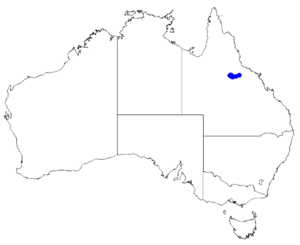Boronia warangensis facts for kids
Boronia warangensis is a special kind of tall, woody bush. It is found only in Queensland, Australia. This plant has unique leaves that are divided into many small parts. It also grows pretty white flowers in clusters where the leaves meet the stem.
Quick facts for kids Boronia warangensis |
|
|---|---|
| Scientific classification | |
 |
|
| Occurrence data from Australasian Virtual Herbarium |
What it Looks Like
Boronia warangensis is a tall, woody bush that usually grows up to about 2 meters (6.5 feet) high. Its leaves are quite special. They are divided twice, meaning they have smaller leaflets on a main stalk. These leaves are about 15 to 56 millimeters long and 18 to 90 millimeters wide. Each leaf has between five and seven small leaflets on a stalk that is 7 to 17 millimeters long. The leaflet at the end is 7 to 30 millimeters long and 1 to 2.5 millimeters wide. The side leaflets are similar but a bit longer.
The flowers are white and grow in groups. You can find between five and twenty-five or more flowers in each cluster. They grow where the leaves join the stem, on a small flower stalk about 2 to 2.5 millimeters long. Each flower has four egg-shaped sepals, which are like small leaves protecting the bud. These sepals are about 1 millimeter long and wide. There are also four petals, each about 2 millimeters long. The parts that make pollen (stamens) have tiny hairs on their edges. The part that receives pollen (stigma) is very small, barely wider than its stalk. This plant mostly blooms from March to September. Its fruit is a smooth, dry seed pod, about 3 millimeters long and 1.5 millimeters wide.
Its Name and History
Boronia warangensis was officially named in 2003 by a scientist named Marco F. Duretto. He described it from a plant he found in the Warang area of the White Mountains National Park. The description was published in a science journal called Muelleria. The second part of its name, warangensis, tells us where it was first found. It refers to the Warang section of the park.
Where it Lives
This type of boronia plant is only found in the White Mountains National Park in Queensland. It grows in areas with bushes or open woodlands, especially where there is sandstone rock.
Looking After it
The Queensland Government Department of Environment and Science has listed Boronia warangensis as "least concern." This means that the plant is not currently in danger of disappearing.

